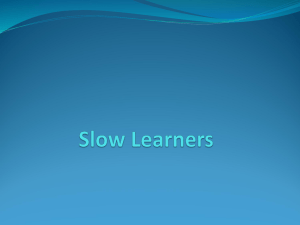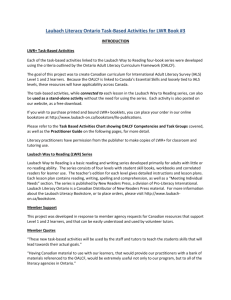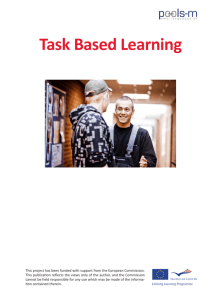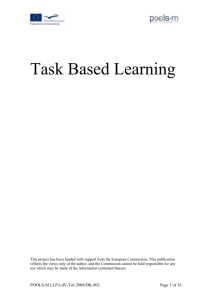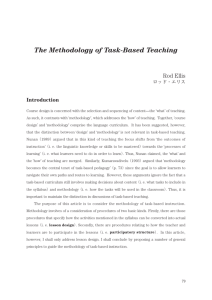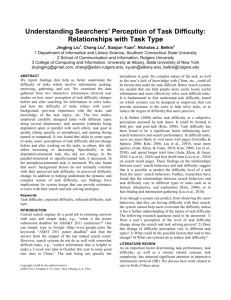The Methodology of Task-Based Language Teaching
advertisement
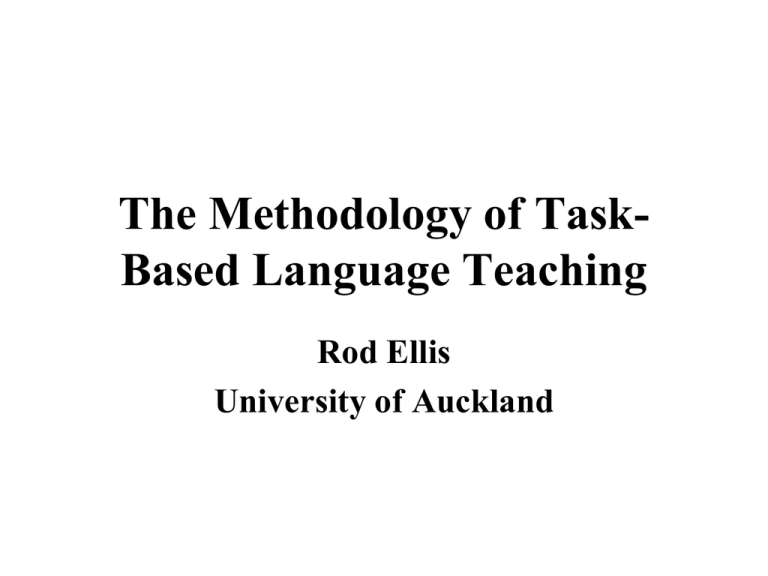
The Methodology of TaskBased Language Teaching Rod Ellis University of Auckland The Methodology of TaskBased Lessons 1. The organisation of task-based lessons - pre-task phase - main task phrase - post-task phase 2. The participatory structure of task-based lessons - individual student activity - teacher-class activity - small group work Organisation (1) – Options for the Pre-Task Phase The purpose of the pre-task phase is to prepare students to perform the task in ways that will promote acquisition. Three approaches: - motivational - focus on cognitive demands - focus on linguistic demands Procedural Options for the Pre-Task Phase 1. Supporting learners in performing a task similar to the main task 2. Providing learners with a model of how the task might be performed. 3. Engaging learners in non-task activities designed to help them perform the task. 4. Providing learners with the opportunity to plan how to perform the task. Performing a Similar Task Cf. Prabhu (1987) - the pre-task is a task in its own right - it is performed through teacher-class interaction with the teacher using questions to guide the students to the task outcome Rationale can be found in sociocultural theory – expert-novice interaction scaffolds zones of proximal development. Providing a Model • Providing a demonstration of an ideal performance • Analysing the features of an ideal text • Training in the use of a strategy (e.g. learning to live with uncertainty) Effects of such task ‘priming’ need investigating (cf. Lam and Wong 2000) Non-Task Preparation Activities These centre of reducing the cognitive or linguistic load: • Activating schema relating to topic of the task (e.g. brainstorming) • Pre-teaching vocabulary (e.g. Newton 2001 - predicting, co-operative dictionary search, matching words and definitions) Strategic Planning Students have access to task. Options: • Unguided planning • Guided planning (focus on content vs. focus on linguistic form) • Time allocated (Mehnert 1998) • Participatory organisation Example of Guided Planning – Foster and Skehan 1999 Strategic planning options Description 1. No planning The students were introduced to the idea of a balloon debate, assigned roles and then asked to debate who should be sacrificed. 2. Guided planning – language focus The students were introduced to the idea of a balloon debate and then shown how to use modal verbs and conditionals in the reasons a doctor might give for not being thrown out of the balloon (e.g. ‘I take care of many sick people – If you throw me out, many people might die.’ 3. Guided planning – content focus The students were introduced the idea of a balloon debate. The teacher presents ideas that each character might use to defend his or her right to stay in the balloon and students were encouraged to add ideas of their own. Organisation (2) - Options for the Main Task Phase Two sets of options: • task-performance options (relating to decisions taken prior to performance of the task) • Process options (relating to on-line decisions taken during the performance of the task) Task Performance Options Main options are: • Performance of task with or without task pressure (Yuan and Ellis 2003) • Performance of task with or without access to input data (‘borrowing’ – Prabhu) • Introduction of surprise element (cf. Foster and Skehan 1997) Process Features 1. Discourse that is ‘conversational’ in nature 2. Discourse that encourages the explicit formulation of messages. 3. Opportunities for students to take linguistic risks. 4. Occasions where the task participants focus implicitly and/or explicitly on specific linguistic forms. 5. Shared goals for the task (including the use of the L1). 6. Effective scaffolding of the studentss’ efforts to communicate in the L2. Form-focussed pedagogy Task-based pedagogy Rigid discourse structure - IRF Loose discourse structure adjacency pairs Teacher controls topic development Students able to control topic development Turn-taking is regulated by the teacher. Turn-taking follows same rules that govern everyday conversation. Display questions Referential questions Students are placed in a responding role and consequently perform a limited range of language functions. Little need or opportunity to negotiate meaning. Students function in both initiating and responding roles and thus perform a wide range of language functions. Opportunities to negotiate meaning when communication problems arise Scaffolding directed primarily at enabling students to produce correct sentences. Scaffolding directed primarily at enabling students to say what they want to say. Form-focussed feedback Content-focussed feedback Echoing Repetition The Danger of Restricted Communication L1: What? L2: Stop. L3: Dot? L4: Dot? L5: Point? L6: Dot? LL: Point, point, yeh. L1: Point? L5: Small point. L3: Dot (From Lynch 1989, p. 124; cited in Seedhouse 1999). Incorporating a Focus on Form Attention to form in the context of performing a task can occur: • Reactively (through negotiation of meaning or form) • Pre-emptively cf. Ellis, Basturkmen and Loewen Implicit Focus-on-Form Two principal procedures: 1. Request for clarification (i.e. Speaker A says something that Speaker B does not understand; B requests clarification allowing A opportunity to reformulate) 2. Recast (i.e. Speaker A says something that Speaker B reformulates in whole or in part) An Example of an Implicit Focus on Form Learner: He pass his house. Teacher: He passed his house? Learner: Yeah, he passed his house. Recasts provide learners with the opportunity to ‘uptake’ the correction. Explicit Focus-on-Form 1. Explicit correction (e.g. ‘Not x, y’) 2. Metalingual comment (e.g. ‘Not present tense, past tense’) 3. Query (e.g. ‘Why is can used here?’) 4. Advise (e.g. ‘Remember you need to use the past tense’). Example of Explicit Focus-onForm Learner 1: Learner 2: And what did you do last weekend? … I tried to find a pub where you don’t see – where you don’t see many tourists. And I find one Teacher: Found. Learner 2: I found one where I spoke with two English women and we spoke about life in Canterbury or things and after I came back Teacher: Afterwards … (Seedhouse 1997) Organisation (3) – The PostTask Phase Three main options: • Repeat performance • Reflection on performance of the task • Attention to form Repeat Performance Research shows that when learners repeat a task their production improves in a number of ways (e.g. complexity increases, propositions are expressed more clearly, and they become more fluent). A repeat performance can be carried out under the same conditions as the first performance (i.e. in small groups or individually) or the conditions can be changed. Reflecting on the Task Performance Students present an oral or written report: - summarising the outcome of the task. - reflecting on and evaluating their own performance of the task. - commenting on which aspect of language use (fluency, complexity or accuracy) they gave primacy to - discussing communication problems - reporting what language they learned from the task - suggesting how they might improve their performance of the task. Attention to Form Options include: - review of learner errors (‘proof listening’ – Lynch) - CR tasks - Production practice - Noticing activities (dictation; making a transcript) Using the Framework 1. Decide on the basic format of the lesson (i.e. which phases to include) 2. Decide on the options to use within each phase The process options provide guidance for the actual performance of the task Some Methodological Principles For Teaching Tasks 1. 2. 3. 4. 5. 6. 7. 8. Ensure an appropriate level of difficulty. Establish clear goals for the performance of the task. Develop an appropriate orientation for performing the task in the students. Ensure the students adopt an active role. Encourage students to take risks. Ensure students are primarily focussed on meaning. Provide opportunities for focussing on form. Require students to evaluate their performance and progress.






